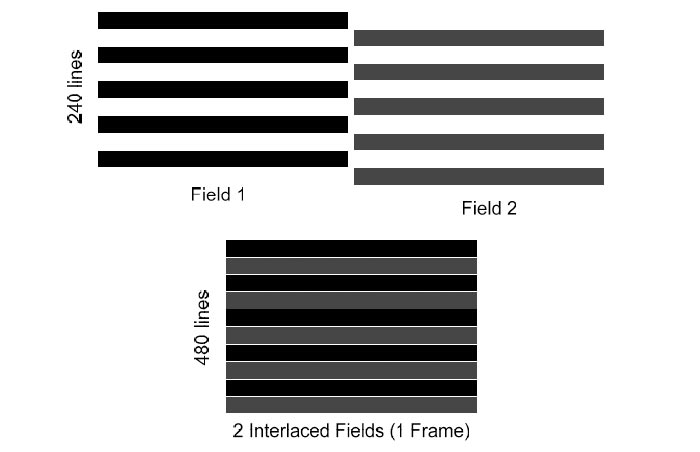CCTV Tips TV Lines (Analog) vs Pixels (Digital Resolution)
What's CCTV resolution?

Resolution is the "Overall picture sharpness" and it's measured by counting horizontal lines (horizontal resolution) and vertical lines (vertical resolution) of an image. The white lines are also counted as a line in the picture. In other words, resolution quantifies how closely the lines are to each other and yet still be visibly counted.

Historically, resolution is understood to mean "limiting resolution," or the point at which adjacent elements of an image cease to be distinguished. Various disciplines measure and specify resolution differently. Resolution can be specified as:
The number of units (i.e.,lines or line-pairs) per unit-distance along the vertical and horizontal axis such as lines/mm
The number of units(i.e.,lines) for a full display such as lines per picture height (LPH)
When to use: Horizontal resolution and vertical resolution.
![]()
Horizontal resolution
The horizontal resolution defines the capability of the system to resolve vertical lines. It depends on the camera and display capabilities, as well as the bandwidth and the high frequency amplitude and phase response of the transmission medium.
In a 4:3 aspect ratio television system, it's expressed as the number of distinct vertical lines, alternately back and white, which can be satisfactorily resolved in three quarters of the width of a television screen.
A system with a horizontal to vertical aspect ratio of 4:3, as in conventional television, needs to allow for (4:3) NV horizontal details to be resolved over the width of the display.
Vertical Resolution
The vertical resolution is independent of the system bandwidth and defines the capability of the system to resolve horizontal lines. It's expressed as the number of distinct horizontal lines, alternately black and white, which can be satisfactorily resolved on a television screen.
Vertical resolution depends primarily on the number of scanning lines per picture and the combined effects of the camera and display capabilities. Ideally, the vertical resolution would be equal to the number of active lines per frame. This would happen if the scanning lines were centered on the picture details.
Most CCTV Resolution uses: TVLines and Pixels

NTSC Analog Video
An NTSC analog video picture is composed of 480 active horizontal lines. When the picture is sent to a monitor or another receiving device, the first field of 240 even-numbered lines is sent, and then the second field of 240 odd-numbered lines is transmitted. This occurs at a rate of 60 fields per second.
The odd and even fields are offset one line apart, so when they are viewed in rapid succession (60 fields per second), they slot into one another to give the illusion of the complete picture-also called a frame, which is made up of 2x240 (or 480)lines. This is called interlaced video.

Resolution (TVL or TV lines) is a monochrome specification that states how many black and white lines can be seen in a given area. With 480 active scan lines, we can see how the theoretical maximum vertical TVL resolution is directly affected by the number of scan lines. (Note: TVL is not equal to scan lines, but vertical TVL is affected by the number of scan lines)
Now that we understand the vertical resolution, we need to understand the horizontal TVL resolution (the number of vertical sampling points). This number varies by camera manufacturer, but they all follow the same definition.
Pixels
Apixel is the smallest element of a digital image. We have all zoomed too far into a picture from a website and seen the image go from clear to a bunch of colored squares-each one of those squares is an individual pixel. A megapixel (MP) is one million pixels, and is a specific measurement for digital resolution that encompasses the area of the output video.
A pixel is generally thought of as the smallest single component of a digital image. However, the definition is highly context-sensitive. For example, there can be "printed pixels" in a page, or pixels carried by electronic signals, or represented by digital values, or pixels on a display device, or pixels in a digital camera (photosensor elements).
![]()
Example: If a camera outputs a signal that is 1280x1024 pixels, it's shooting at a megapixel resolution of 1280x1024=1,310,720 pixels=1.3megapixels(MP)
In precise technical terms, "lines of resolution" refers to the limit of visually resolvable lines per picture height. In other words, it's measured by counting the number of horizontal or vertical black and white lines that can be distinguished on an area that is as wide as the picture is high.
It's impossible to give an exact correlation between an analog and digital resolution, 640 pixels gives a conversion to 480TVL(to work out the conversion the equivalent TVL is 75% of the number of pixels in this caera 75% of 640).
For example if you are recording at 640x480(VGA resolution) you have 640 horizontal lines of pixels by multiplying to 75 you get 480 meaning that to get the best detail possible at VGA resolution, you need a camera that captures 480TV Lines or better.
Analog to Digital
In the analog world, 480 active scan liens and 75 percent of the horizontal area identify resolution. With digital, we still have a 3x4 aspect ratio, but pixels or sensing points now take the place of scan lines. Like cameras, these digital "picture grabers" come in different levels of resolution (e.g.,176x144,352x240,704x480). Like a steel chain, the picture quality of your system will only be as good as your weakest link.
![]()
Get My Latest Posts
Subscribe to get the latest updates.
Your email address will never be shared with any 3rd parties.
Tags: CCTV System, CCTV Tips